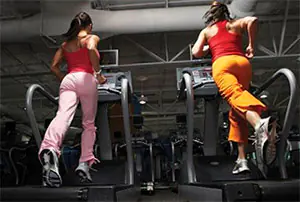Many of those athletes who squat with a barbell weighing three times their own achieved these results precisely thanks to cardio training. They conducted such seemingly “frivolous” classes at least 2 times a week, allocating 20-30, and sometimes 45 minutes for them.
Cardio training in the gym at first glance is not the most exciting activity. Much more interesting is swimming, basketball, or tennis. But this tedious activity has its advantages.
- Firstly, you can use a machine that provides aerobic exercise, excluding those muscle groups that are quite tired during the athletic activity.
- Secondly, all modern cardio equipment is equipped with special devices that allow you to track intensity. That is, an athlete who is afraid of preserving his muscle mass will not spend a single extra second on a cardio machine if he knows his required dose of aerobic exercise.
In general, any athlete who works out in the gym 3-4 times a week must at least occasionally include a cardio session in his training program. This is necessary not only to warm up the muscles before training, but, first of all, to ensure that the heart and lungs - as well as the muscles being trained - receive the necessary dose of stress.
Especially “frivolous” training is needed for professionals - in order to strengthen the heart and lungs and help the body quickly restore energy resources. The fact is that the body of a tired athlete, spending energy on the absorption of nutrients and the accumulation of ATP, needs more oxygen. Poorly developed lungs and a not very powerful cardiovascular system in such cases are subject to very great stress.
How long should the “ventilation period” last? How long should one aerobic session take? What exercises and in what variety are best to perform? Beginners and amateurs often ask these questions to gym instructors. Bad coaches usually get off with phrases like: “Look at the complex on the wall, everything is written there.” But the competent ones answer: “This is an individual question. Because it all depends on your weight, sports experience and endurance level.”
The physiology of each person is individual. Therefore, both the cardio cycle and the frequency of aerobic training will be different for everyone.
For those who are seriously aiming to get rid of excess fat, it is enough to include 15-20 minutes of walking on a ski machine after an athletic workout, at least 3 times a week. Some people think that if, after the main fitness session, they pedal an exercise bike until exhaustion, the fat will go away faster and the muscles will become more prominent. This opinion is only half true. In this case, the fat will go away quickly, of course, but the quality of the muscles may suffer as a result. This is especially true for those groups that have been developed through enormous efforts.
For those whose main goal is to shape their figure, without the concomitant development of physical strength and muscle mass, you can increase the time and frequency of cardio training, but within reasonable limits. If you do fitness 5 times a week, and pedal a bicycle ergometer for an hour every day after strength exercises, this will definitely harm the general condition of the body and will not have a very good effect on muscle tissue.
The gym has plenty of cardio equipment. Which one is better? On heavy squat day, you can use a stepper. This will be useful not only for the heart and lungs, but also for the legs, which need a slight cool-down after hard work - to speed up the blood and prevent joints.
On a day when your legs are practically not used, you can pedal a bicycle ergometer or work on a ski machine. The ski machine can also be used on a day of heavy bench presses and arm training - as a cool-down for the muscles and joints of the torso.
Post Views: 98


